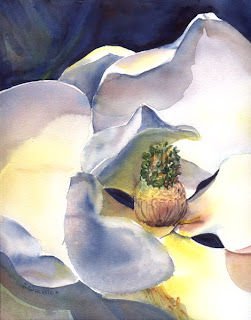
On January 8, 2009, I am starting a series of watercolor workshops that will focus on how to paint whites. The first of these lessons will demonstrate how to make a white shape three-dimensional. As you can see, this is a white flower, but it moves in and out of the flat space of the paper.
To paint whites, artists have to be aware, first of all, that whites are not white. Artists also have to learn a new language, the language of “ish” words. They have to become very sensitive to describing the type of white. This is a great lesson in learning to see color. For example, is that white “green-ish” or “pink-ish” or “blue-ish?” Because whites reflect color around them, the artist has to be sensitive to these “ish” colors. But sometimes these colors are not so subtle. The most amazing shadows I ever witnessed occurred one morning when I was lying in bed. The sun was streaming into the room and the ceiling fan over my bed cast a double shadow onto the white ceiling. One shadow was bright green and the other was deep red. It took me a while to figure out that the color for those shadows was being picked up from the colorful quilt on my bed!
Study this painting of the magnolia blossom. How many different “whites” can you see? Isn’t it amazing that our brain identifies which areas are white and which are not, even though some of the white areas are painted blue? Try to imagine how this painting would look if all my shadow areas were painted grey. Would the painting be as interesting?


